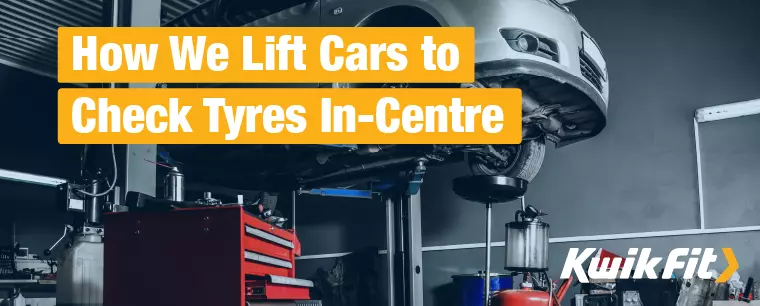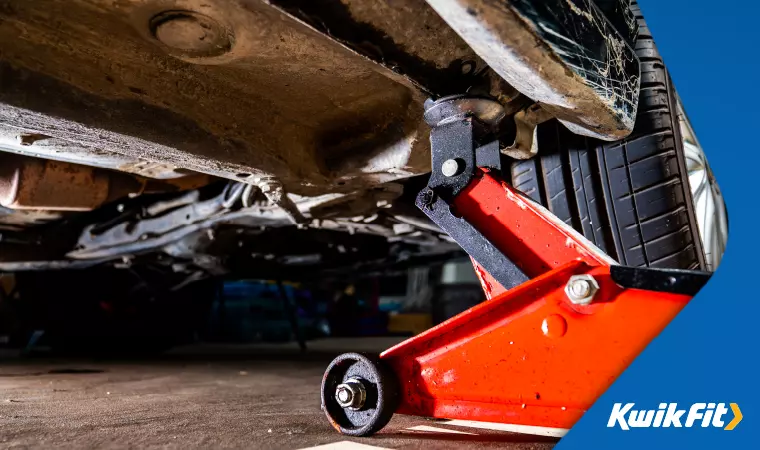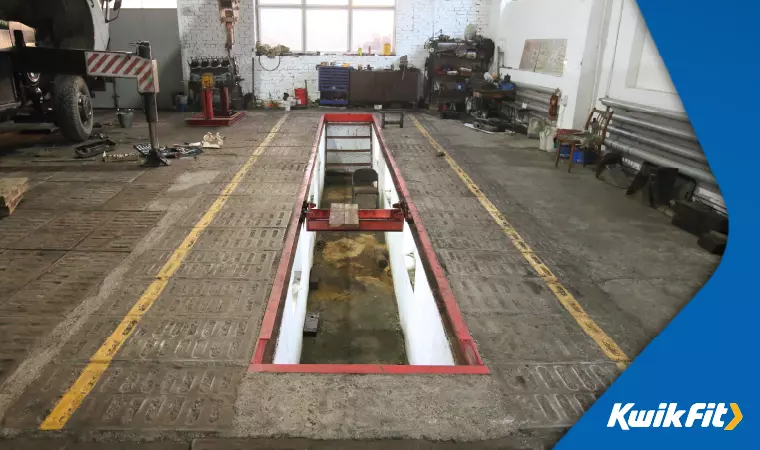How We Lift Cars to Check Tyres In-Centre
Jack Dreyer | Friday 19th May 2023 8:00am

Lifting cars is dangerous work. Improper lifting can result in the car slipping – not only seriously damaging the car but creating a really hazardous situation for those nearby. Luckily, all our technicians are expertly trained to lift cars properly and safely – keeping themselves safe and keeping your car in top condition.
As you may expect, we need to lift cars to inspect, repair, and replace components underneath the car – but we also lift them to inspect tyres! How do we do so, and why is it important to lift a car for tyre inspections?
Let’s find out.
How we lift cars in-centre

Almost all Kwik Fit centres are fitted with full size car ramps that help our technicians quickly and safely lift vehicles – though there are vehicle size and weight limitations with different lifts, so be sure to check whether your vehicle is suitable for the lifts at your local centre.
Professional vehicle lifts
There are different types of lifts available to auto technicians. Some are scissor lifts and some are jacking-point lifts that need one for each corner. These all basically work by being recessed into the ground – you drive the car over the right area, make sure the pressure points are aligned, and slowly lift the car.
Car lifts that work by lifting at the jacking points are usually synchronised to lift all at the same time so that the technician doesn’t have to run around and lift each corner at a time. These have a huge benefit of making practically the whole underside of the car accessible at various heights, so is almost essential for under-body welding work, as well as some other fiddly repairs. But, depending on the particular pressure point, they’re also more likely to slip as there’s less in contact with the car – so it’s essential that only experts use these.
Pits & ramps
Aside from lifts, it’s common to see pits or ramps in use. With ramps, you carefully drive the car up two ramps (one for each side of the car) – the gap in the middle means you can walk through and carry out the necessary work. Ramps used to be the favoured method, but getting a car up them required very precise steering and clutch control. Pits, on the other hand, are much simpler (literally holes in the ground for technicians to get into) but are only really common for working on large commercial vehicles like lorries, recovery vehicles, buses, and RVs – essentially vehicles so large that it’s impractical to lift them for every repair.
Both ramps and pits have a real downside compared to lifts in that they both rely on the car’s wheels and suspension to keep the car in place. This means you can’t use a ramp or pit to repair suspension or change a tyre.

Hand Jacks
The other common way of lifting a car is a good, old-fashioned jack. The safest jacks are high-strength trolley jacks, but you’ll likely have seen scissor or bottle jacks used for emergency or roadside repair (such as changing to a spare wheel).
Benefits of lifting cars to inspect tyres
The clearest benefit to lifting cars completely off the ground (using lifts or jacks rather than ramps) is to get a clear view of the entire face of the tyre and enable you to rotate the tyre completely. Keeping the car on the floor means you have to go forward or reverse in an arc motion to be able to see the whole tyre – which requires much more space, more coordination between technicians, more time, and makes it much more likely to miss possible issues.
When our technicians lift your car, they’ll be able to get as close as they like to the tyres, rotate each one through a whole turn, and mark out any problematic areas that they’ve spotted: things like cuts, bulges, or tread pattern wear. The other key benefit is that they’ll be able to get a good look on the inside sidewall of the tyre – where damage is less likely to happen but also less likely to be spotted using conventional methods.
This is essential for accurately testing the tread depth of each tyre and helps to maintain complete safety on our roads. It also essentially removes the possibility of a car getting damaged during jacking or when going onto ramps – so it’s a win-win method!
Questions about your tyres?
If you’re concerned about one or more of your tyres, the experts at your local Kwik Fit can conduct a free tyre inspection for complete peace of mind – and can usually repair or replace tyres on a same-day basis.
Any facts, figures and prices shown in our blog articles are correct at time of publication.
Featured Articles
Is it Illegal to Drive With One Headlight?
Saturday 19th July 2025
Wondering if it’s illegal to drive with one headlight? Learn about the safety risks and penalties of illegal blown bulbs and why you should fix them promptly.
Air Con in EVs & Hybrids: Experts Answer Your Questions
Monday 30th June 2025
Does air con drain EV batteries? Can you use the air con while charging an electric car? Find out the answers to these questions & more from Kwik Fit’s experts.
Why Is Your Car Making a Noise? Fixes & Tips
Friday 13th June 2025
When your car starts making unexpected noises, it can certainly be quite disconcerting; it may be nothing to worry about, but here’s what you need to know.









